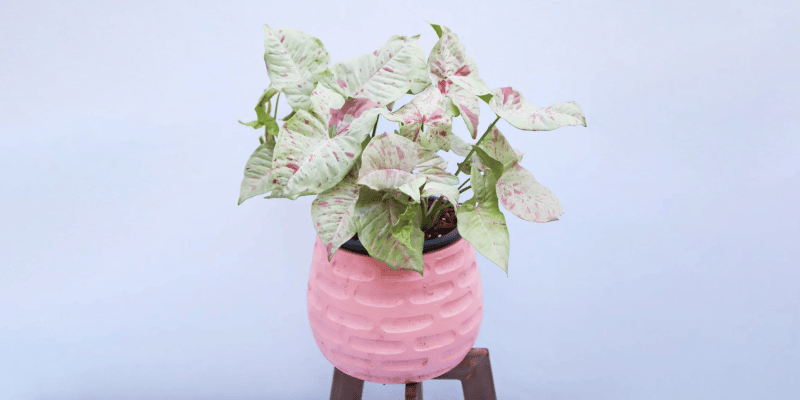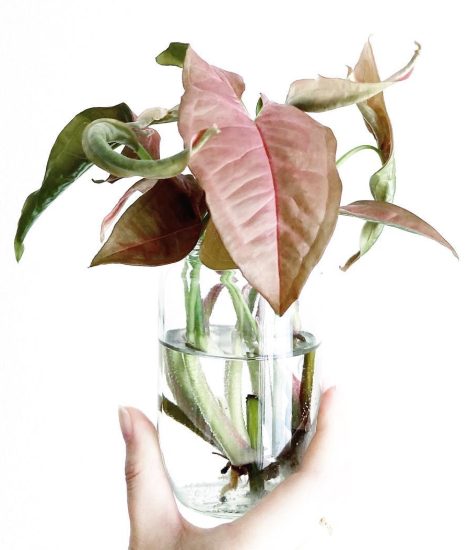Syngonium (or Arrowhead plant) is easy to care for, features some incredible variegation, and is at home in a hanging basket or in a tight cluster in a pot.
They propagate more quickly in water than most other vines, and depending on your placement, they’ll even customize their growth.
There are more than dozens of colorful varieties of Syngonium, and their sturdy tropical origin makes them easy even for beginners.
We’ll cover propagation, growing, and the most common issues we see with Syngonium plants in this care guide.
Table of Contents
Syngonium Plant Care Guide
History, habitat, and characteristics
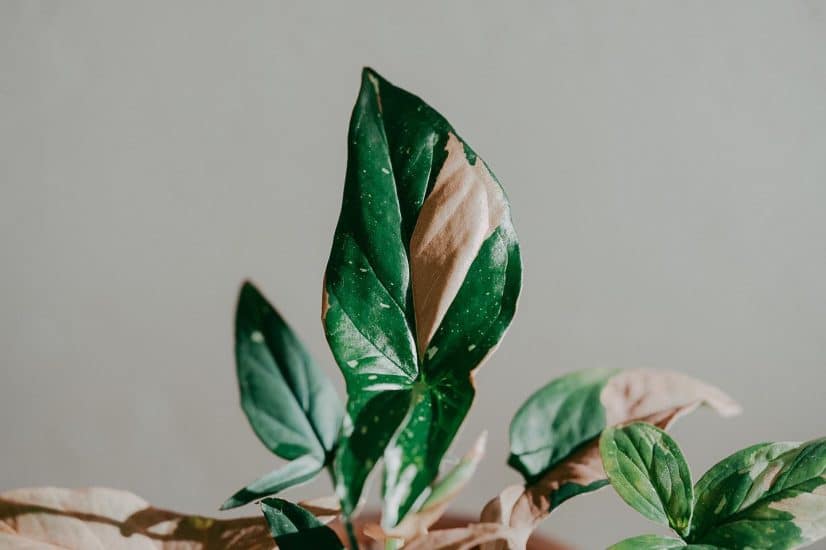
Syngonium (Arrowhead Plant), a genus of the Arum family (Araceae), is an epiphyte native to Central and South America, primarily to tropical and subtropical forests. It is also known as the Nephthytis, as the two were originally confused and thought to be the same plant. More commonly, it’s known as the arrowhead plant — a literal reference to the shape of its juvenile leaves.
In the wild, we see Syngonium plants dozens of feet in the air, but indoors, they tend to grow roots that limit them a bit lower than the ceiling (thankfully).
These are fantastic plants to keep indoors because they thrive in a variety of conditions, and since Syngonium refers to the entire genus, you can be sure there are loads of varieties to choose from, each with its own characteristics.
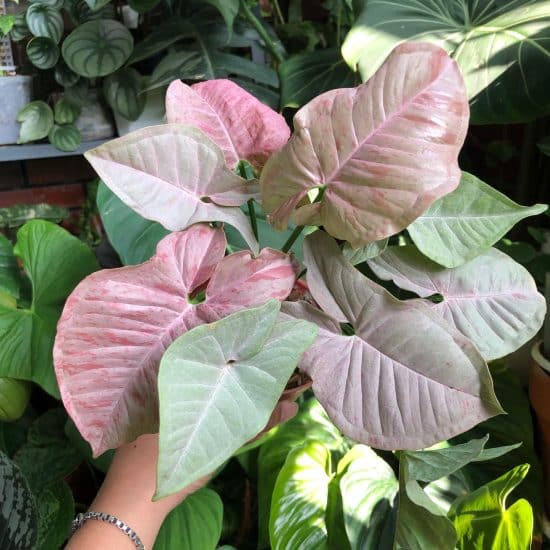
Syngoniums that love to adapt to their conditions, and as natural epiphytes (they grow on other plants for support in the wild), they can do equally well in a pot, against a moss pole, or in a hanging basket.
Caring for a Syngonium is actually pretty easy. They prefer moist soil and to be rootbound, so they don’t need frequent repotting. You can prune them back as desired or train them up trellises, walls, or poles. This characteristic feature allows this lovable houseplant to create its own unique story in the home!
These plants are great for dorm rooms, small apartments with undersized windows, or even a brightly lit home. They’re versatile, especially if you shop around a bit for a variety that matches your purpose. Older plants will sport large leaves and more mature root systems, making them easier to take care of.
OK, let’s cover a few of those varieties!
Syngonium varieties
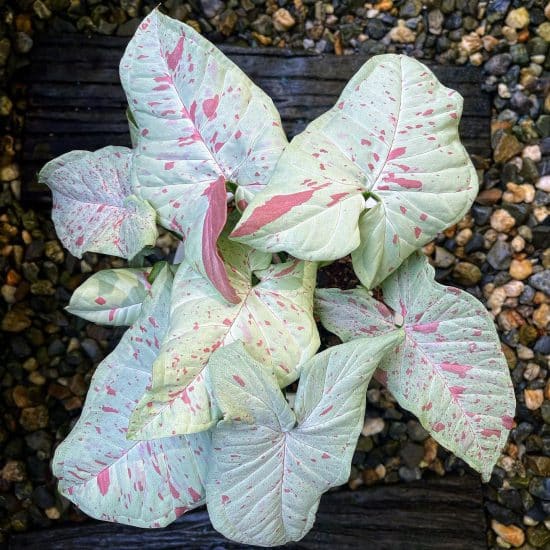
The Syngonium family is composed of many species and varieties, each possessing unique characteristics. Syngonium podophyllum is perhaps the best-known species, with rounded or arrow-shaped leaves, while Syngonium wendlandii is distinguished by its cone-shaped leaves and strong odor.
Other notable varieties include Syngonium ‘Albo Variegata’, featuring cream and green variegated leaves, and Syngonium ‘Pink Butterfly’, Syngonium ‘Pink Allusion’, and Syngonium ‘White Butterfly’, with delicate and brightly colored variegations.
What truly makes Syngonium remarkable is its ability to propagate through thermogenesis, meaning it can produce warm flowers and a potent odor to attract pollinating beetles from afar! This also brings us to a caveat: the smells of some varieties can get a bit… strong.
On to our Syngonium care guide, but first some reassurance: as an indoor plant, Syngonium doesn’t interact with many beetles.
Light
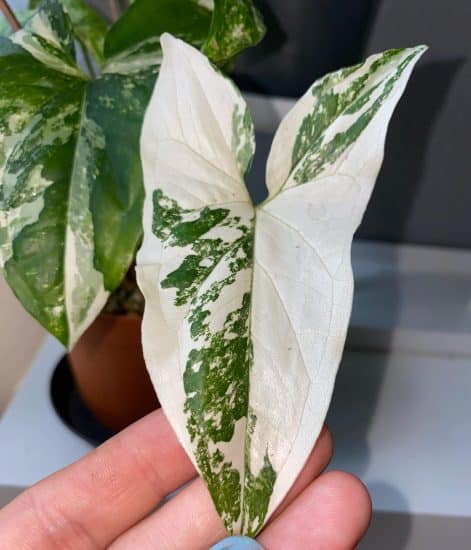
Looking at leaf variegation is your first sign of how much light these plants need. Less green means less chlorophyll, which means more light is required. If you keep heavily variegated plants in low light conditions, you’ll either damage your plant or lose a lot of its variegation as it adapts to extract more energy from the light it’s given.
Arrowhead vines prefer bright, indirect light, and do best when placed near a north- or east-facing window. These windows provide the ideal amount of indirect sunlight for the plant, about 6 hours a day. During the winter months, you may need to move the plant closer to a light source. For south- or west-facing windows, it’s essential to place the plant slightly further away from the window to avoid direct sunlight.
Inspect your Syngonium regularly to make sure it’s receiving the right amount of light. Signs that it may not be getting enough light are leaf discoloration, weak stems, and slow growth. If the plant is getting too much light, you’ll notice yellowing of the leaves, dryness, and crispy tips.
Speaking of…
Tips:
- In lower light conditions, you can add LED lights to make sure your Arrowhead vines hit the mark.
- Syngonium will thrive with 6 or more hours of bright, indirect light per day.
- Avoid direct sun exposure, as it can cause leaf damage, and watch for signs of too much or too little light, such as dark green leaves or yellowing/fraying of leaves.
- If your arrowhead vine features creamy, green leaves and lots of variegation, be careful about low light conditions. These variegated varieties need lots of bright light to preserve their unique coloration.
Water
Taking care of your Syngonium is like a dance — you want to keep the soil consistently moist without over-saturating. But how often should you give it a whirl (or water)? Well, that depends on the size of your plant and the season.
Smaller pots tend to need more frequent water, so with that, younger plants need a little bit more attention… and twirling. Okay, the metaphor falls apart a little bit here.
In order to ensure you don’t have either too much or too little water, use your finger to measure the moisture level of the soil. Stick your finger in the dirt. If the top inch of soil feels dry, then it’s time to give your Syngonium a drink. Don’t be shy about giving it a good soak, but don’t let pooling occur at the bottom of the pot either. Syngonium are sensitive to cold water, so aim for room temperature water that’s filtered, distilled, or even collected right from the sky (well, in a rainwater collection system).
It’s also important to keep in mind that too much water is damaging. To prevent overwatering, ensure your pot has drainage holes. Excess water that pools around the pot can cause root rot. Look out for signs that your houseplant is getting too much water — yellowing or falling leaves, limp and soft stems, and overly damp soil are common indicators of overwatering.
Temperature and humidity
Let’s start with temperature: think of it as a dress code – not too formal and not too casual, somewhere right in the middle. For Syngonium, this means temperatures between 65-80 degrees Fahrenheit. It doesn’t like the cold – anything below 50 degrees can shock your plant, like a waiter at a fancy restaurant bringing an appetizer to your table in a bikini.
Now, on to humidity. An arrowhead plant needs moisture, but like anyone overdoing it with makeup, too much isn’t ideal. Humidity levels in the 45-60% range are where you want to keep them.
The easiest way to do this is by using a humidifier or setting up a pebble tray. Place a few inches of water in a shallow tray and place it under the pot of your Arrowhead plant. This will help raise the humidity in the immediate area around the plant without allowing too much moisture to infiltrate your whole house.
You could also consider grouping several plants together to make your own little humidity-filled jungle.
Soil and planting
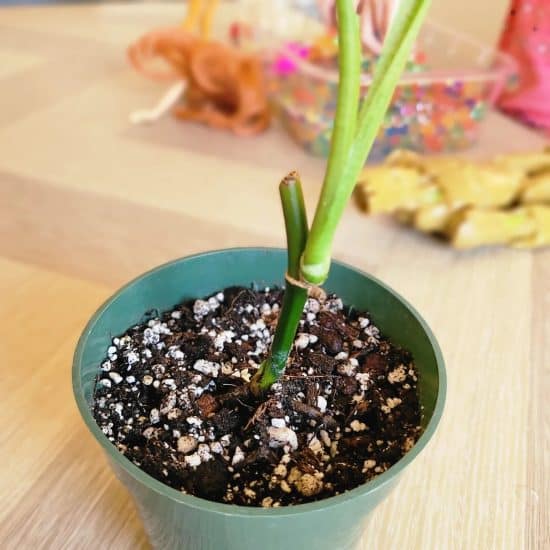
Syngonium prefers moist soil, so we want to use a mix that doesn’t compact too much and still lives room for your plant to breathe.
For your Arrowhead plant, I recommend a mix of:
- Potting soil. The basis for well-draining soil is a store-purchased potting soil (avoid garden soil). No integrated fertilizer is necessary.
- LECA/perlite/coco coir. We’ll add some aeration, water retention, and fluff it up a little bit.
- Shredded bark. Absolutely key for epiphytes. They love creating a symbiotic fungus between the interface of bark and root system. This helps with nutrient/moisture uptake and can even defend the plant against diseases.
Syngonium plants, like a lot of indoor plants, actually prefer to be a bit root bound. So before replanting, really make sure you see the roots coming up out of the pot or migrating through the drainage holes on the bottom. For pot material, anything can work, but I prefer to avoid terracotta pots because they tend to wick out moisture a bit too quickly for Syngonium.
With aerial roots, you can train them with a moss pole (which these plants adore) or trim them to keep it neat and tidy. Trimming/pruning also depends on if you’re encouraging the leggy growth that a hanging basket loves to feature, or if you want to keep things neat and in a tight bunch.
Pruning is pretty simple — just grab a pair of clean scissors and cut close to the soil. If you want, you can even transfer these as propagations (we’ll cover that in a bit).
If you have it, worm castings or horticultural charcoal is fantastic to add to the soil. Charcoal naturally purifies the soil, balances the pH, and stimulates the growth of microorganisms that can in turn provide potassium and phosphorus for this plant. Arrowhead vine is actually very phosphorus-dependent, so maybe even go out of your way to find some of this ingredient.
Propagation guide
As an epiphyte, Syngonium podophyllum is easy to propagate through a stem-cutting method and grows very quickly in water. I recommend propagating during its growing season (spring/summer): it’s a bit faster, and the parent plant often deals better with pruning/cuts.
To propagate Syngonium:
Gather some jars, water, and sterilized scissors or knife.
- Snip a stem cutting (around six inches long) with at least a few leaves still attached. Make sure to cut just below a leaf node point. The plant it comes from should be healthy and well-established.
- Remove any lower leaves from the stem cutting, leaving no more than three — this will help prevent the cutting from rotting when you place it in water.
- Place your jar in a humid location with plenty of light (just not too direct).
- Switch out the water every few days with clean room temperature water.
- In a few weeks, you should see roots reaching a few inches long. This is your cue to replant into the same potting soil you used for the mother plant.
A note on nodes.
Nodes: if you aren’t familiar, these are points on a stem where roots, buds, or leaves can cross. You’ll see them as small little bumps, so when you place the stem in water, these are where your roots will stem from. When taking your cutting, you need to make sure you cut just under one of these points, so you get roots at the bottom of the stem.
Syngonium stem cuttings are genetically identical to the parent plant, so if you have a variegated plant, now you have two or three of the same! If you have one you like, share the wealth with your friends and fam!
Common issues
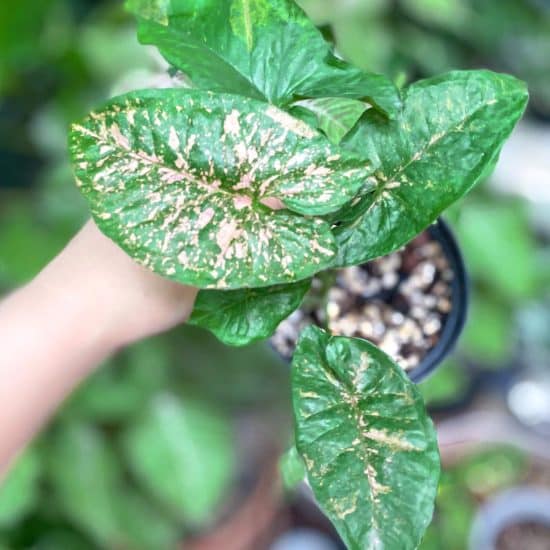
As we mentioned above, the Arrowhead plant is pretty easy to care for and thrives in a diversity of conditions, but all indoor plants can suffer some of the same issues. Let’s cover the most common so you can detect them early and fix them easily!
Nutrient Deficiency
Syngonium may suffer from nitrogen and phosphorous deficiencies, each with its own distinct signs. Nitrogen deficiencies often appear as yellowing of the leaves and can also indicate the soil is too dry. Phosphorous deficiencies are identified by stunted growth and necrotic spots on the leaves. To restore the adequate nutrient balance in your Syngonium, apply a balanced fertilizer solution or switch out the soil completely.
Leaf Burn and loss of variegation
The Arrowhead plant is, unfortunately, no stranger to leaf burn, especially with its variegated species. This occurs when a plant is exposed to too much direct sunlight. An early symptom is a leaf turning completely green, and then you’ll notice browning around the edges as it becomes crispy, or even thin, white spots in the center of a leaf. The remedy is simple: less direct light will bring back those healthy light green leaves.
Diseases and pests
We’ll cover two issues we see a lot in Arrowhead vines: pests and root rot. Both are symptoms of larger issues with your Arrowhead plant care and mean that adjustments are necessary. Typically, this means too much water or lack of pruning damaged leaves/stems.
Root Rot
Symptoms include yellowing leaves, wilting, and brown spots. Check to see if the soil is compact and more than lightly moist. If it is, you’ll want to investigate the root system itself. If you notice smelly, black or brown, mushy roots, you’ll want to cut them off (clean the scissors before and after with alcohol or boiling water) and repot in fresh soil.
Water a bit less frequently, and if you felt like you already were, check the soil section above for how to add to add drainage and aeration to your potting mix. While Arrowhead plants do like wetter soil than many other tropical plants, there is a limit to how much water they can be exposed to for extended periods.
Pests
Spider mites are a type of arachnid, which are related to ticks and spiders, that feed off of the sap in Syngonium, which can cause damage and discoloration. Symptoms of spider mite infestation are clusters of small mites, white spots on the leaves, and the appearance of webbing. Spider mites can quickly reproduce, making them difficult to control and eliminate.
In order to prevent and treat a spider mite infestation, you first want to make sure you have a healthy plant full of healthy leaves. Any dead leaves can be pinched off. If you do have spider mites, you’ll want to physically remove them and their webs (cold water works great) and then apply neem oil.
Conclusion
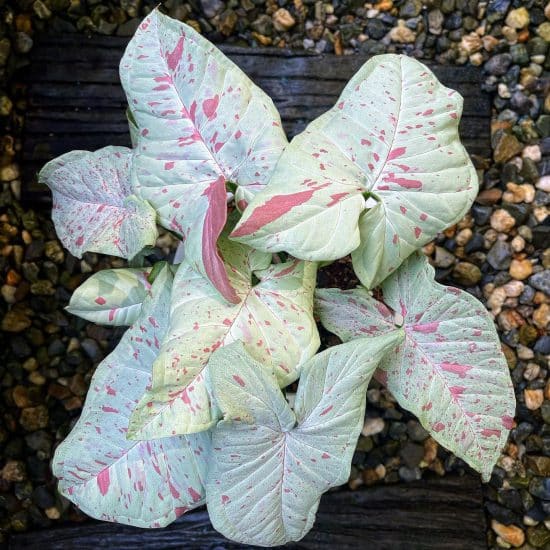
The Syngonium plant is easy to care for, will customize its growth to your unique environment, and is happy in humid conditions, if you can stand the high humidity yourself.
If customization is up your alley, people are propagating and discovering nearly endless varieties of this plant every day. From pink veins to creamy light green leaves, you’re certain to find a color scheme that fits your decor.
(The picture just above is of Syngonium ‘Milk Confetti.’)
Remember: apply fertilizer in the summer or spring (avoid in cooler months), prune as needed to get the look you want, and keep those cuttings in water, because they’ll soon be new plants for your friends!
FAQ
Can an arrowhead vine grow on a moss stick?
Arrowhead vines adore a moss pole, and you can encourage your aerial roots to attach by either tying them off or weaving them into the pole’s moss/netting.
How much direct sunlight can an Arrowhead plant receive per day?
We really recommend zero, if possible. But especially with dark green varieties, you should be okay with an hour or two, especially if it’s not from a south or west-facing window, which can often be a bit hotter and brighter.
Do Syngonium plants need liquid fertilizer?
They don’t require liquid fertilizer, but do greatly benefit from it especially after they’re well-established. Overfertilization can look a lot like leaf burn, so make sure to dilute and only apply monthly in the growing season.
How do you promote Arrowhead vines to grow roots?
Moisture, moisture, moisture. Arrowhead vines are naturally seeking moist interfaces (like they do in the wild), so you can spray a pole with water where roots are contacting, or keep humidity high around your plant.
Like other tropical plants, this is also why they thrive and will show new growth if exposed to above-average household humidity. This is a plant that loves it wet, so make sure that pot has a drainage hole or two so that excess water has somewhere to go.
Do different Syngonium podophyllum varieties require different care?
Just a little bit. Different plants often differ in the amount of indirect sunlight they want. Darker species can thrive in low light settings, where creamy white varieties of Syngonium (like the ‘Cream Allusion Nephthytis’) benefit from brighter conditions.
Are Arrowhead vines invasive?
In many subtropical climates, they are considered invasive and have been artificially introduced to new environments where they quickly outcompete the local flora. What can you do? Make sure any trimmings are discarded in sealed plastic bags and wear gloves to avoid skin irritation.

